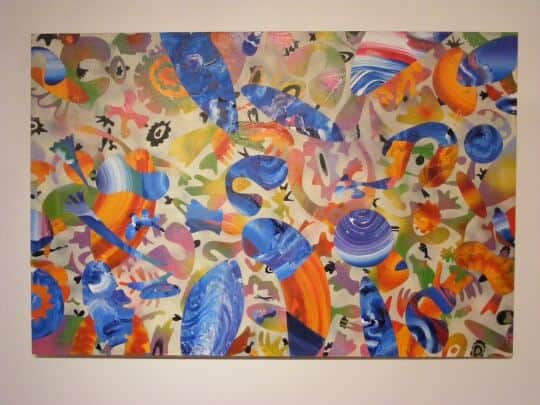Roy Dunningham has covered several Creative Hawke’s Bay Invitationals for BayBuzz. Here he reviews the current 2011 Invitational, exhibiting at the Hastings City Art Gallery through June 26th.
Creative Hawke’s Bay Invitational 2011
By Roy Dunningham
This year’s Creative Hawke’s Bay Invitational at the Hastings City Art Gallery should be the best yet, but it isn’t. The portents were good, the right artists and the right balance of invitations and selection, but Helen Kedgley’s resulting show just lacks the dark edge that sparked last year’s show.
Don’t get me wrong. It is still a good exhibition and well worth seeing as a showcase of local talent. In particular, it is gratifying in this day and age to see some good quality painting.
Matthew Couper might well be our most original painter. His idiosyncratic imagery, sourced mainly from late Gothic and early Renaissance painting, bears little relationship to anything else in New Zealand art at present. Originally, I suspect, he was interested in the actual quirkiness of symbolism, but now he is using it to tell his own story as he shifts between California and New Zealand; although it may take you some time to unravel that story.
Wellesley Binding is another painter who would not seem out of place if he were transported back 500 years. Change the allegorical demons of painters like Bosch and Grunewald for Binding’s suit-wearing dark eminences of the corporate world and it fits quite well. Binding’s demons go about their work in the shadows of spin doctoring, cynically doing deals that manipulate our lives and environment for their own personal profit. Technically and subjectively this is powerful painting.
It was a real bonus to discover the work of Anthony Chiappin, a relative newcomer to Hawke’s Bay. His take on suburbia is a terrific painting. There are no specific images here, only a hint perhaps of streets and landscape features. And yet the artist’s ideas communicate so strongly and his control of paint to achieve a wide range of effects is exemplary.
Another impressive newcomer to the Invitational is Kezia Whakamoe. She hasn’t yet achieved Chiappin’s degree of control, but she paints with an emotional intensity that is rare in emerging artists and, like most Toi Mairangi graduates, she knows how to use paint. Watch this space.
Other works that held an excitement factor were Ruth McLean’s utterly delightful ink study and the controlled energy of Paula Taafe’s “Limnological”.

Limnological by Paula Taaffe (acrylic and oil on canvas)
For sheer risk taking, though, you have to go to Grant Beran who uses actual chemical processes of developing and fixing photographs to make his images. These fugitive processes, along with his graffiti-like references, create a disturbingly, contemporary feeling of an uncertain world.
There are some sophisticated landscapes from Freeman White and Callum Arnold, a thoughtful duo from Michelle Bryant, and a wonderfully nostalgic recall of the 1960s Wellington Blues Club scene by Fane Flaws.

A Further Untitled Adventure with The Council of the Psychedelic Ids by Fane Flaws (oil on canvas)
Recent work from Prakash Patel has been overly designed for my tastes, but his “The Fisherman” is a beautifully intuitive painting which invites the viewer to re-visit it for further discoveries. The best work I have seen from him.
Photography includes some strongly observed landscapes from Richard Brimmer and Ashley Cox and a surreal, domestic interior vignette from Denise Wilkinson. Video presentations are not usually my art form of preference, but Phil Dadson’s “Between Worlds” is enchanting. You have to allow a little time to see this presentation through.
The most disappointing area is the 3-dimensional work. It isn’t bad at all, but just doesn’t excite much. Having said that, David Trubridge’s “Tipu” is stunning, even by his high standards and Chris Bryant-Toi presents an imposing gateway encrypted with thoughts on the branding of the new Hawke’s Bay Museum and issues of management of Maori treasures.
Linda Bruce’s work becomes more surreal each year and is none the worse for that. Increasingly she involves the viewer’s instinctive associations with seemingly random objects to construct a possible scenario for her work.
There are some quite cerebral pieces from Peter Baker and Martin Selman and a clever low relief re-visiting of kowhaiwhai from Ngataiharuru Taepa. Craft doesn’t seem to figure much in these exhibitions now, but Chris Wilson’s Chaise Longue stands out as a stylish meeting of old world decadence and new world improvisation. And it is really comfortable – I just had to sit on it.
Print-making is not much in evidence either, but Jill Webster’s digitally sourced “Post cards from Cern” are well worth a careful look. Webster’s work is always intelligently conceived and it is fitting that here she is exploring the process and history of our irrepressible search for knowledge.
Ironically perhaps, intelligence might be some of the problem with the show. Most of the work is thoughtfully planned, approachable – and safe. There is not too much challenge for viewers and the fires of passion seem to have burned a bit lower this year.
May 24, 2011

Thank you so much ( Roy) for creating this review and the media space ( Tom and Brook) for it to be read and enjoyed. This is a thought provoking, interesting, eloquent and real description of this curated show. Reading this enhances my experience of looking at and engaging with these works of art. This is stimulating and now I will go back again to the Hastings City Art Gallery and have a deeper look and conversation with these artworks.
Thank you so much for the comp Roy!